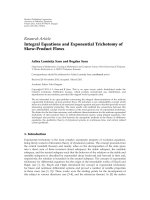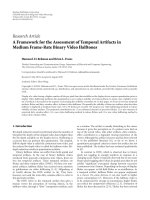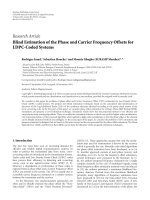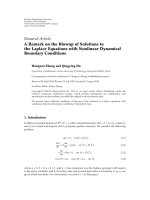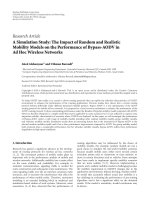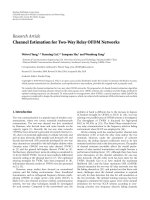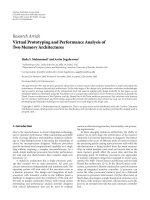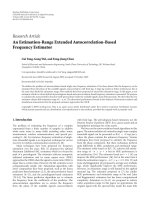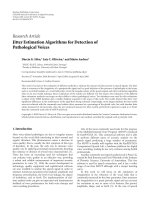Báo cáo hóa học: " Research Article DOA Estimation in the Uplink of Multicarrier CDMA Systems" docx
Bạn đang xem bản rút gọn của tài liệu. Xem và tải ngay bản đầy đủ của tài liệu tại đây (718.67 KB, 9 trang )
Hindawi Publishing Corporation
EURASIP Journal on Wireless Communications and Networking
Volume 2008, Article ID 851726, 9 pages
doi:10.1155/2008/851726
Research Article
DOA Estimation in the Uplink of Multicarrier CDMA Systems
Antonio A. D’Amico, Michele Morelli, and Luca Sanguinetti
Department of Information Engineering, University of Pisa, Via Caruso, 56126 Pisa, Italy
Correspondence should be addressed to Antonio A. D’Amico,
Received 15 May 2007; Accepted 23 October 2007
Recommended by Luc Vandendorpe
We consider the uplink of a multicarrier code-division multiple-access (MC-CDMA) network and assume that the base station
is endowed with a uniform linear array. Transmission takes place over a multipath channel and the goal is the estimation of the
directions of arrival (DOAs) of the signal from the active users. In a multiuser scenario, difficulties are primarily due to the large
number of parameters involved in the estimation of the DOAs which makes this problem much more challenging than in single-
user transmissions. The solution we propose allows estimating the DOAs of different users independently, thereby leading to a
significant reduction in the system complexity. In the presence of multipath propagation, however, estimating the DOAs of a given
user through maximum-likelihood methods remains a formidable task since it involves a search over a multidimensional domain.
Therefore, we look for simpler solutions and discuss two alternative schemes based on the SAGE and ESPRIT algorithms.
Copyright © 2008 Antonio A. D’Amico et al. This is an open access article distributed under the Creative Commons Attribution
License, which permits unrestricted use, distribution, and reproduction in any medium, provided the original work is properly
cited.
1. INTRODUCTION
Antenna arrays at the base station (BS) can dramatically im-
prove the capacity of a communication system [1–3]. Ac-
tually, they can be exploited in various ways. First, to form
retrodirective beams that select the desired signals and at-
tenuate the interfering ones. Secondly, antenna arrays make
it possible to implement space-time selective transmission
in the downlink. Finally, they can provide accurate local-
ization of the user terminals [4], which is of interest in ad-
vanced handover schemes, public safety services, and intel-
ligent transportation systems. In all these applications, ac-
curate estimation of the directions of arrival (DOAs) of the
desired signals is required.
DOA estimation has received much attention in the past
years and several solutions are available in the technical lit-
erature (see [5–9] and the references therein). In particular,
the schemes discussed in [5, 6] have good performance but
are only devised for single-user applications and cannot be
directly used in the uplink of a multiuser system. A tuto-
rial review of subspace-based methods for DOA estimation
is provided in [7]. The main drawback of these algorithms is
that they can only handle a limited number of users since the
overall number of resolvable paths cannot exceed the num-
ber of sensors in the antenna array. For this reason their ap-
plication to a scenario with tens of users and several paths
per user (as envisioned in fourth generation wireless sys-
tems) seems hardly viable. Schemes for estimating the DOAs
in a CDMA multiuser system have been recently proposed in
[8, 9]. In particular, the method discussed in [9]concentrates
on a single user’s parameters and models the multiple-access
interference (MAI) as colored Gaussian noise. This idea is ef-
fective as it splits the multiuser DOA estimation problem into
a series of simpler tasks in which DOAs of different users are
estimated independently instead of jointly. A possible short-
coming of this method is that it requires knowledge of the
MAI covariance matrix, which must be estimated in some
manner.
In the present paper, we consider the uplink of a multi-
carrier code-division multiple-access (MC-CDMA) network
[10, 11] and propose a method for estimating the DOAs of
each active user. Transmission takes place over a multipath
time-varying channel in which several paths with possibly
different DOAs are present for each user. In a multiuser sce-
nario the main obstacle is the large number of parameters in-
volved in the estimation of the DOAs which makes this prob-
lem much more challenging than in single-user transmis-
sions. A practical solution to this problem consists of separat-
ing each user from the others before applying conventional
DOA estimation schemes. For this purpose, we first estimate
2 EURASIP Journal on Wireless Communications and Networking
the channel response and the data symbols of each active user
by resorting to the method discussed in [12]. Once channel
estimates and data decisions are obtained, they are exploited
to reconstruct the interfering signals, which are then sub-
tracted from the received waveform. This produces an MAI-
free signal which is finally used for DOA estimation. In this
way the DOAs are estimated independently for each user but,
contrarily to [9], no knowledge of the MAI statistics is re-
quired.
In spite of the significant simplification achieved by
means of users’ separation, estimating the DOAs of a given
user through ML methods is still difficult as it involves a
numerical search over a multidimensional domain. To re-
duce the system complexity we investigate two alternative
schemes. The first is based on the space-alternating gener-
alized expectation-maximization (SAGE) algorithm [13], in
which the DOAs of a given user are estimated sequentially in-
stead of jointly. This reduces the original multidimensional
problem to a sequence of one-dimensional searches. The
second scheme exploits the ESPRIT (Estimation of Signal
Parameters by Rotational Invariance Techniques) algorithm
[14] and estimates the DOAs in closed form.
The main contribution of this paper is a method for esti-
mating the DOAs of all active users in an MC-CDMA sce-
nario characterized by multiple resolvable paths. As men-
tioned previously, the major difficulty comes from the need
of separating each user from the others before his DOAs can
be estimated. Notice that conventional DOA estimation algo-
rithms cannot be employed in such a scenario unless users’
separation has been successfully completed, since otherwise
the number of sensors in the antenna array should be pro-
hibitively high (on the order of the total number of resolv-
able paths). To the best of the authors’ knowledge, a similar
problem has previously been addressed only in [15]. In par-
ticular, the solution proposed in [15] is tailored for the rate
3/4 space-time block code introduced by Tarokh in [16]and
assumes a static channel with a single DOA for each user. Un-
fortunately, its extension to a time-varying multipath chan-
nel with possibly multiple DOAs for each user does not seem
straightforward. A second contribution is a comparison be-
tween two popular schemes, namely, the SAGE and ESPRIT
algorithms, both in terms of estimation accuracy and system
complexity.
The rest of the paper is organized as follows. Section 2
describes the signal model and introduces basic notation. In
Section 3 we derive the methods for estimating the DOAs.
Simulation results are discussed in Section 4 and some con-
clusions are offered in Section 5.
2. SIGNAL MODEL
2.1. MC-CDMA system
We consider the uplink of an MC-CDMA network employ-
ing N subcarriers for the transmission of N
u
<Ndata sym-
bols. The N
u
modulated subcarriers are located in the middle
of the signal bandwidth and are divided into smaller groups
of Q elements [17]. The remaining N
− N
u
subcarriers at the
edges of the spectrum are not used to limit the out-of-band
radiation (virtual carriers). The BS is equipped with P an-
tennas and employs the subcarriers of a given group to com-
municate with K users that are separated through orthogo-
nal Walsh-Hadamard (WH) codes of length Q
≥ K. Without
loss of generality, we concentrate on a single group and as-
sume that the Q subcarriers are uniformly spread over the
signal bandwidth so as to exploit the channel frequency di-
versity. We denote
{i
n
;1 ≤ n ≤ Q} the subcarrier indices in
the group, with i
n
= i
1
+(n − 1)N
u
/Q.
The ith symbol a
k
(i)ofthekth user is spread over Q chips
using the code sequence c
k
= [c
k
(1) c
k
(2) ··· c
k
(Q)]
T
,
where c
k
(n) ∈{±1/
Q} and the notation (·)
T
means trans-
pose operation. The resulting vector a
k
(i)c
k
is then mapped
onto Q subcarriers using an OFDM modulator. The chan-
nel is assumed static over an OFDM block (slow-fading) and
an N
G
-point cyclic prefix (longer than the channel impulse
response) is inserted to avoid interference between adjacent
blocks.
At the receiver side the incoming waveform is first fil-
tered and then sampled with period T
s
= T
B
/(N + N
G
),
where T
B
is the block duration. Next, the cyclic prefix is
removed and the remaining samples are passed to an N-
point discrete Fourier transform (DFT) unit. We concen-
trate on the mth MC-CDMA block and denote X
p
(m) =
[X
p
(m, i
1
) X
p
(m, i
2
) ··· X
p
(m, i
Q
)]
T
the demodulator out-
puts at the pth antenna corresponding to the Q subcarriers
of the considered group. Also, we assume a quasisynchronous
system in which each user is time-aligned to the BS reference
in a way similar to that discussed in [18]. In these circum-
stances we have
X
p
(m) =
K
k=1
a
k
(m)u
p,k
(m)+w
p
(m), p = 1, 2, , P,
(1)
where u
p,k
(m)isaQ-dimensional vector with entries
u
p,k
m, n
=
H
p,k
(m, i
n
)c
k
(n), 1 ≤ n ≤ Q,(2)
and H
p,k
(m, i
n
) is the kth user’s channel frequency re-
sponse over the i
n
th subcarrier at the pth antenna. Also,
w
p
(m) = [w
p
(m, i
1
) w
p
(m, i
2
) ··· w
p
(m, i
Q
)]
T
is thermal
noise, which is modeled as a Gaussian vector with zero mean
and covariance matrix σ
2
I
Q
(we denote I
Q
the identity matrix
of order Q).
2.2. Channel model
We assume that the P receive antennas are arranged in a
uniform linear array with interelement spacing δ. The sig-
nal transmitted by each user propagates through a multipath
channel with L distinct paths. Thus, the kth baseband chan-
nel impulse response (CIR) at the pth antenna during the
mth MC-CDMA block takes the form
h
p,k
(m, t) =
L
=1
α
,k
(m)e
j(p−1)ω
,k
(m)
g
t − τ
,k
(m)
,(3)
where g(t) is the convolution between the impulse responses
of the transmit and receive filters, τ
,k
(m) is the delay of the
Antonio A. D’Amico et al. 3
-path and α
,k
(m) the corresponding complex amplitude.
Finally, ω
,k
(m)isdefinedas
ω
,k
(m) =
2π
λ
δ sin
ϕ
,k
(m)
,(4)
where λ is the free-space wavelength and ϕ
,k
(m) is the DOA
of the -path. From (4) we see that measuring ω
,k
(m)is
equivalent to measuring ϕ
,k
(m) since there is a one-to-one
relation between these quantities provided that ϕ
,k
(m)is
limited within
±90
◦
and δ ≤ λ/2. In the following we assume
that the path delays and DOAs do not change significantly
with time, that is, we set τ
,k
(m) ≈ τ
,k
and ϕ
,k
(m) ≈ ϕ
,k
.
Vice versa, the path gains α
,k
(m) are modeled as indepen-
dent Gaussian random processes with zero-mean and aver-
age power σ
2
= E{|α
,k
(m)|
2
}.
The channel frequency response H
p,k
(m, i
n
)iscomputed
as the Fourier transform of h
p,k
(m, t)atf = i
n
/T and reads
H
p,k
m, i
n
=
G
i
n
L
=1
α
,k
(m)e
− j2πi
n
τ
,k
/T
e
j(p−1)ω
,k
,(5)
where T
= NT
s
is the duration of the useful part of the MC-
CDMA block and G(i
n
) is the frequency response of g(t)at
the i
n
th subcarrier. In the sequel, we assume that the N
u
mod-
ulated subcarriers are located within the flat region of G(i
n
).
In these circumstances, H
p,k
(m, i
n
)reducesto
H
p,k
m, i
n
=
L
=1
α
,k
(m)e
− j2πi
n
τ
,k
/T
e
j(p−1)ω
,k
,(6)
where G(i
n
) has been set equal to unity without loss of gen-
erality.
Notice that our multiuser scenario assumes KL resolvable
paths. In practice, KL may be so large to prevent the joint es-
timation of the DOAs of all active users. To overcome this
obstacle, we propose to estimate the DOAs of each user sepa-
rately. In doing so we first compute estimates of the channel
responses and data symbols of all active users. Next we ex-
ploit these results to reconstruct the interfering signals and
cancel them out from the DFT output, thereby isolating the
signal of the desired user. The problem of channel estima-
tion and data detection is accomplished using the method
discussedin[12] which provides accurate results with lim-
ited complexity. For this purpose, we assume that the MC-
CDMA blocks are organized in frames. As shown in Figure 1,
eachframeiscomposedbyN
B
data blocks preceded by N
T
training blocks that are exploited to get initial estimates of
H
p,k
(m) (acquisition). Such estimates are then updated dur-
ing the data section of the frame (tracking) by means of the
least-mean-square (LMS) algorithm.
3. DOA ESTIMATION
In this section, we show how the channel estimates and
data decisions are exploited to perform DOA estimation.
To this end, we denote by
{a
k
(m)} the data decisions and
by
{
H
p,k
(m, i
n
)} the estimates of the channel frequency re-
MC-CDMA blocks
Subcarriers
1
2
.
.
.
N
N
T
training blocks N
B
data blocks
Figure 1: Frame structure.
sponses. We begin by computing the following quantities
during the mth received block:
y
p,k
m, i
n
=
Qa
∗
k
(m)c
k
(n)
X
p
m, i
n
−
K
=1
/
= k
a
(m)c
(n)
H
p,
m, i
n
,
k
= 1, 2, , K.
(7)
Substituting (1)-(2) into (7) and assuming
H
p,
(m, i
n
) ≈
H
p,
(m, i
n
)anda
(m) ≈ a
(m) yields
y
p,k
m, i
n
=
H
p,k
m, i
n
+ w
p
m, i
n
,(8)
wherewehaveset
|a
k
(m)|=1 which is valid for PSK con-
stellations. Letting d
,k
(m, i
n
) = α
,k
(m)e
− j2πi
n
τ
,k
/T
,from(6)
we see that y
p,k
(m, i
n
) can also be written as
y
p,k
m, i
n
=
L
=1
d
,k
m, i
n
e
j(p−1)ω
,k
+ w
p
m, i
n
. (9)
It is worth noting that apart from thermal noise, only the
contribution of the kth user is present in the right-hand side
(RHS) of (9). This amounts to saying that the quantities
{y
p,k
(m, i
n
)} are MAI-free and, therefore, they can be used
to estimate the DOAs of the kth user. In this way, DOA esti-
mation is performed independently for each active user in-
stead of jointly and the complexity of the overall estimation
process is significantly reduced.
As mentioned in Section 2.2, measuring ω
,k
is equivalent
to measuring the DOA ϕ
,k
. Without loss of generality, in this
section we concentrate on the first user and aim at estimat-
ing ω
1
= [ω
1,1
ω
2,1
··· ω
L,1
]
T
based on the observation of
{y
p,1
(m, i
n
)}. Since the ML estimation of ω
1
is prohibitively
complex as it involves a numerical search over a multidimen-
sional domain, in the sequel we discuss two practical DOA
estimators based on the SAGE and ESPRIT algorithms. For
notational simplicity, we drop the subscript identifier for the
first user.
4 EURASIP Journal on Wireless Communications and Networking
3.1. ML estimation
During the mth received block, the quantities
{y
p
(m, i
n
)} are
arranged into P-dimensional vectors
y
m, i
n
=
y
1
m, i
n
y
2
m, i
n
···
y
P
m, i
n
T
n = 1,2, ,Q.
(10)
We assume slow channel variations so that d
(m, i
n
)canbe
considered practically constant over N
s
consecutive blocks.
Then, we divide the data section of the frame into adjacent
segments, each containing N
s
blocks, and compute the fol-
lowing average:
Y
r
i
n
=
1
N
s
N
s
−1
i=0
y
i + rN
s
− N
s
+ N
T
, i
n
, r = 1, 2, , R,
(11)
where r is the segment index and R denotes the number of
segments within the frame (the number of data blocks in
each frame is N
B
= N
s
× R). Substituting (9) into (11), bear-
ing in mind that d
(m, i
n
) ≈ d
(rN
s
− N
s
/2, i
n
) over the rth
segment (i.e., for N
T
+ rN
s
− N
s
≤ m ≤ N
T
+ rN
s
− 1), yields
Y
r
i
n
=
L
=1
d
,r
i
n
f
ω
+ η
r
i
n
, (12)
where d
,r
(i
n
) = d
(rN
s
− N
s
/2, i
n
), f(ω
)hasentries
[f(ω
)]
p
= e
j(p−1)ω
(1 ≤ p ≤ P)and{η
r
(i
n
)} are
statistically independent Gaussian vectors with zero-mean
and covariance matrix C
η
= (σ
2
/N
s
)I
P
. Letting F(ω) =
[f(ω
1
) f(ω
2
) ··· f(ω
L
)], we may rewrite (12) in the equiv-
alent form
Y
r
i
n
=
F(ω)d
r
i
n
+ η
r
i
n
, (13)
where d
r
(i
n
)hasentries[d
r
(i
n
)]
= d
,r
(i
n
)for1≤ ≤ L.
We now jointly estimate ω and
{d
r
(i
n
)} based on the ob-
servation of
{Y
r
(i
n
)} for 1 ≤ r ≤ R and 1 ≤ n ≤ Q. Dropping
irrelevant terms and factors, the log-likelihood function for
ω and
{d
r
(i
n
)} takes the form
Λ
d
r
i
n
, ω
=−
R
r=1
Q
n=1
Y
r
i
n
− F
ω
d
r
i
n
2
, (14)
where
{
d
r
(i
n
)} and ω are trial values of the unknown param-
eters while
· denotes Euclidean norm. Keeping ω fixed and
letting
d
r
(i
n
) vary, the minimum of (14)isachievedfor
d
r
i
n
=
F
H
ω
F
ω
−1
F
H
ω
Y
r
i
n
,
1
≤ r ≤ R,1≤ n ≤ Q.
(15)
Next, substituting (15) into (14) and maximizing with re-
spect to
ω produce
ω = arg max
ω
R
r=1
Q
n=1
Y
H
r
i
n
F
ω
×
F
H
ω
F
ω
−1
F
H
ω
Y
r
i
n
.
(16)
Unfortunately there is no closed form solution to the maxi-
mization of (16). The only possible approach is to perform
a search over the L-dimensional space spanned by
ω. As the
computational load would be too intense, in the next subsec-
tion we employ the SAGE algorithm to find an approximate
solution of (16).
Remark 1. The ML estimators (15)-(16) have been derived
using channel estimates given in (7). In principle, one can di-
rectly use the estimates provided by the LMS channel tracker,
which are more or less correlated depending on the value of
the step-size employed in the tracking algorithm. In contrast,
assuming perfect interference cancellation, it is easily recog-
nized that (7) provides uncorrelated channel estimates that
facilitate the derivation of the joint ML estimator of ω and
{d
r
(i
n
)}. Since the additional complexity involved by (7)is
negligible, we have adopted the latter approach.
3.2. SAGE-based estimation
In a variety of ML estimation problems the maximization
of the likelihood function is analytically unfeasible as it in-
volves a numerical search over a huge number of parame-
ters. In these cases the SAGE algorithm proves to be effec-
tive as it achieves the same final result with a comparatively
simpler iterative procedure. Compared with the more famil-
iar EM algorithm [19], the SAGE has a faster convergence
rate. The reason is that the maximizations involved in the
EM algorithm are performed with respect to all the unknown
parameters simultaneously, which results in a slow process
that requires searches over spaces with many dimensions.
Vice versa, the maximizations in SAGE are performed vary-
ing small groups of parameters at a time. In the following,
the SAGE algorithm is applied to our problem without fur-
ther explanation. The reader is referred to [13] for details.
Returning to the joint estimation of ω and
{d
r
(i
n
)},we
apply the SAGE algorithm in such a way that the parame-
ters of a single path are updated at a time. This leads to the
following procedure consisting of cycles and steps. A cycle is
made of L steps and each step updates the parameters of a
single path. In particular, the -step of the ith cycle looks for
the minimum of
λ
d
,r
i
n
, ω
=
R
r=1
Q
n=1
Y
(i)
,r
i
n
−
d
,r
i
n
f
ω
2
,
(17)
where Y
(i)
,r
(i
n
) ∈ C
P
is defined as
Y
(i)
,r
i
n
= Y
r
i
n
−
−1
q=1
d
(i)
q,r
i
n
f
ω
(i)
q
−
L
q=+1
d
(i−1)
q,r
i
n
f
ω
(i−1)
q
,
(18)
and
{
d
(i)
q,r
(i
n
), ω
(i)
q
} denotes the estimate of {d
q,r
(i
n
), ω
q
} at
the ith cycle. It is worth noting that Y
(i)
,r
(i
n
)representsanex-
purgated version of Y
r
(i
n
), in which the latest estimates of
Antonio A. D’Amico et al. 5
{d
q,r
(i
n
), ω
q
} are exploited to cancel out the multipath inter-
ference. Minimizing (17)withrespectto
{
d
,r
(i
n
), ω
} pro-
duces
ω
(i)
= arg max
ω
Ψ
(i)
ω
,
(19)
d
(i)
,r
i
n
=
1
P
f
H
ω
(i)
Y
(i)
,r
i
n
,1≤ r ≤ R,1≤ n ≤ Q,
(20)
with
Ψ
(i)
ω
=
R
r=1
Q
n=1
f
H
ω
Y
(i)
,r
i
n
2
. (21)
Note that only one-dimensional searches are involved in
(19).
The following remarks are of interest.
(1) The maximization in the RHS of (19)ispursued
through a two-step procedure. The first (coarse search)
computes Ψ
(i)
(ω)overagridofN
g
values, say
{ω
(j); j = 1, 2, , N
g
}, and determines the location
ω
max
of the maximum. In the second step (fine search)
the quantities
{Ψ
(i)
(ω
(j))} are interpolated and the
local maximum nearest to
ω
max
is found.
(2) From (21) it follows that Ψ
(i)
(ω) is a periodic function
of
ω with period 2π. Thus, the maximum of Ψ
(i)
(ω)
lies in the interval (
−π, π] and, in consequence, the es-
timator (19) gives correct results provided that
|ω
| <
π.From(4) it is seen that this condition is easily met
using an antenna array with interelement spacing less
than half the free-space wavelength.
(3) In applying the SAGE we have implicitly assumed
knowledge of the number L of paths. In practice L is
unknown and must be established in some way. One
possible way is to choose L large enough so that all the
paths with significant energy are considered. Alterna-
tively, an estimate of L can be obtained in the first cycle
as follows. Physical reasons and simulation results in-
dicate that in any cycle the multipath components are
taken in a decreasing order of strength. On the other
hand, if
{
d
(1)
,r
(i
n
)} are the estimates of {d
,r
(i
n
)} at the
first cycle, an indication of the energy of the th path
is
E
=
1
RQ
R
r=1
Q
n=1
d
(1)
,r
i
n
2
. (22)
Thus, the first cycle may be stopped at that step, say
,where
E
drops below a prefixed threshold and
L =
− 1 may be taken as an estimate of the number of
significant paths.
(4) The computational load of the SAGE is assessed as
follows. Evaluating
{Y
(i)
,r
(i
n
)} for r = 1, 2, , R and
n
= 1,2, ,Q needs O(RQLP)operationsateach
step. The complexity involved in the computation of
{
d
(i)
,r
(i
n
)} in (20)isO(RQP) while O(RQPN
g
)opera-
tions are required to compute the quantities Ψ
(i)
(ω(j))
for j
= 1,2, , N
g
. Denoting N
i
the number of cycles
and bearing in mind that each cycle is made of L steps,
it follows that the overall complexity of the SAGE is
O[RQLPN
i
(L + N
g
+ 1)].
3.3. ESPRIT-based estimation
An alternative approach for estimating the DOAs relies on
subspace-based methods like the MUSIC (Multiple Signal
Classication) [20] or ESPRIT algorithms [14]. In the follow-
ing we discuss DOA estimation based on ESPRIT. The reason
is that this method provides estimates in closed form while a
grid-search is needed with MUSIC.
To begin, we exploit vectors
{y(m,i
n
)} in (10)tocompute
the sample correlation matrix
R
y
=
1
N
B
Q
Q
n=1
N
T
+N
B
−1
m=N
T
y
m, i
n
y
H
m, i
n
. (23)
Then, based on the forward-backward (FB) approach [21],
we obtain the following modified sample correlation matrix
R
y
=
1
2
R
y
+ J
R
T
y
J
, (24)
in which J is the exchange matrix with 1’s on its antidiagonal
and 0’s elsewhere.
In the ESPRIT method, the eigenvectors associated with
the L largest eigenvalues of
R
y
are arranged into a P × L
matrix V
= [v
1
v
2
··· v
L
]. Next, we consider the matri-
ces V
1
= [I
P−1
0]V and V
2
= [0I
P−1
]V,where0 is an L-
dimensional column vector with zero entries. The estimate
of ω
is eventually obtained as
ω
= arg
λ
∗
, = 1, 2, , L, (25)
where
{λ
1
, λ
2
, , λ
L
} are the eigenvalues of
S
=
V
H
1
V
1
−1
V
H
1
V
2
, (26)
and arg
{λ
∗
} denotes the phase angle of λ
∗
in the interval
[
−π, π).
The following remarks are of interest.
(1) A necessary condition for the existence of (V
H
1
V
1
)
−1
in
RHS of (26) is that the number of rows in V
1
is greater
than or equal to the number of columns. Since V
1
has
dimension (P
− 1) × L, the above condition implies
that P
≥ L + 1, that is, the number of antennas must
be greater than the number of multipath components.
We also observe that the inverse of F
H
(ω)F(ω) in the
ML estimator (16) exists provided that F(
ω)isfullrank
and P
≥ L. Thus, DOA estimation with ESPRIT needs
one more antenna compared with the ML estimator.
It is worth noting that the minimum number of an-
tennas required by both schemes is inde pendent of the
number K of contemporarily active users.
(2) The number of paths can be estimated using the mini-
mum description length (MDL) criterion [22]. To this
purpose, let μ
1
≥ μ
2
··· ≥ μ
P
be the eigenvalues of
6 EURASIP Journal on Wireless Communications and Networking
the correlation matrix
R
y
in (24) (arranged in a non-
increasing order of magnitude). Then, an estimate of L
is computed as
L = arg min
L∈{0,1, ,P−1}
−
N
B
Q
P −
L
log
GM
L
AM
L
+
1
4
L
2P −
L +1
log
N
B
Q
,
(27)
where
L is a trial value of L while GM(
L) and AM(
L)
denote the geometric and arithmetic means of
{μ
i
;
L +
1
≤ i ≤ P} respectively, that is,
GM
L
=
P
i=
L+1
μ
i
1/(P−
L)
,
AM
L
=
1
P −
L
P
i=
L+1
μ
i
.
(28)
(3) The complexity of the ESPRIT is assessed as follows.
Evaluating
R
y
in (23) needs O(P
2
N
B
Q)operations.
Bearing in mind that inverting an L
× L matrix re-
quires O(L
3
) operations, it follows that the complexity
involved in the computation of S in (26) is approxi-
mately O[L
2
(L +3P)]. Finally, computing the eigen-
vectors of S needs O(L
3
) operations. In summary, the
overall complexity of the ESPRIT is O[P
2
N
B
Q+L
2
(2L+
3P)]. In writing this figure we have ignored the oper-
ations required to compute
R
y
, V
1
,andV
2
since these
matrices are easily obtained from
R
y
with negligible
complexity.
4. SIMULATION RESULTS
4.1. System parameters
We consider a cellular system operating over a typical ur-
ban area with a cell radius of 1 km. The transmitted sym-
bols belong to a QPSK constellation and are obtained from
the information bits through a Gray map. The number of
modulated subcarriers is N
u
= 48 and the DFT has di-
mension N
= 64. Walsh-Hadamard codes of length Q = 8
are used for spreading purposes. The signal bandwidth is
B
= 8 MHz, so that the useful part of each MC-CDMA block
has length T
= N/B = 8 microseconds. The sampling pe-
riod is T
s
= T/N = 0.125 microsecond and a cyclic prefix
of T
G
= 2 microseconds is adopted to eliminate interblock
interference. This corresponds to an extended block (includ-
ing the cyclic prefix) of 10 microseconds. The users are syn-
chronous within the cyclic prefix and have the same power.
The carrier frequency is f
0
= 2 GHz (corresponding to a
wavelength λ
= 15 cm) and the interelement spacing in the
antenna array is δ
= λ/2. The channel impulse responses of
the active users are generated as indicated in (3) with three
paths (L
= 3). Pulse g(t) has a raised-cosine Fourier trans-
form with roll-off 0.22 and duration T
g
= 8T
s
= 1mi-
crosecond. The path delays and DOAs of the desired user are
equal to (τ
1
= 0,ϕ
1
= 0
◦
), (τ
2
= 1.5T
s
, ϕ
2
=−20
◦
), and
(τ
3
= 3.5T
s
, ϕ
3
= 45
◦
). Vice versa, path delays and DOAs
of the interfering users are uniformly distributed within [0,
1] microseconds and [
−60
◦
,60
◦
], respectively, and are kept
constant over a frame. For all active users (including the de-
sired one), the path gains have powers
σ
2
= σ
2
H
exp (−), = 0, 1,2, (29)
where σ
2
H
is chosen such that the channel energy is normal-
ized to unity, that is, E
{H
p,k
(m)
2
}=1. Each path varies
independently of the others within a frame and is generated
by filtering a white Gaussian process in a third-order lowpass
Butterworth filter. The 3-dB bandwidth of the filter is taken
as a measure of the Doppler rate f
D
= f
0
v/c,wherev denotes
the speed of the mobile terminal and c
= 3 × 10
8
m/sisthe
speed of light.
A simulation run begins with the generation of the chan-
nel responses of each user. Channel acquisition is performed
using Walsh-Hadamard training sequences of length N
T
= 8
while channel tracking is accomplished by exploiting data de-
cisions provided by a parallel interference cancellation (PIC)
receiver [12]. Throughout simulations the number of data
blocks per frame is set to N
B
= 128. Once channel estimates
and data decisions are obtained, they are passed to the pro-
posed SAGE- or ESPRIT-based DOA estimators. The SAGE
computes the function Ψ
(i)
(ω)overagridofN
g
= 64 values
and it is stopped at the end of the second cycle (N
i
= 2). Pa-
rameter N
s
in (11) is fixed to 16, so that R = N
B
/N
s
= 8. The
mobile velocity, the number of users, and the number of an-
tennas are varied throughout simulations so as to assess their
impact on the system performance.
4.2. Performance assessment
The system performance has been assessed in terms of root
mean-square-error (RMSE) of the DOA estimates. For sim-
plicity, the number L of paths is assumed perfectly known at
the receiver.
Figure 2 illustrates the performance of the SAGE-based
scheme versus E
b
/N
0
(E
b
is the average received energy per
bit and N
0
/2 is the two-sided noise power spectral density)
for a half-loaded system (K
= 4). The mobile speed is 10 m/s
and the number of sensors in the array is P
= 6. Marks in-
dicate simulation results while solid lines are drawn to ease
the reading. We see that the curves exhibit a floor. In par-
ticular, the RMSE of the weakest path is approximately 15
degrees for E
b
/N
0
> 10 dB. The appearance of the floor can
be explained as follows. Inspection of (19)and(21)reveals
that at the first step of the first cycle, the SAGE looks for the
maximum of the periodogram ψ
(1)
1
(ω). Neglecting the effect
of thermal noise, we expect that ψ
(1)
1
(ω) has three peaks lo-
cated at the angular frequencies ω
i
= π sin ϕ
i
for i = 1, 2,3.
As is known [21], in periodogram-based methods the width
of the main lobe is approximately 2π/P. It follows that if a
pair of angular frequencies are separated by less than 2π/P,
then the corresponding peaks appear as a single broader peak
(smearing effect). In these circumstances the two paths can-
not be resolved and large estimation errors may occur even
Antonio A. D’Amico et al. 7
24211815129630
E
b
/N
0
(dB)
0
5
10
15
20
25
RMSE (degrees)
1st path
2nd path
3rd path
SAGE
K
= 4, P = 6
v
= 10 m/s
Figure 2: Performance of the SAGE estimator with K = 4, P = 6,
and v
= 10 m/s.
in the absence of noise. Note that in Figure 2 we have ω
1
= 0,
ω
2
=−π sin 20
◦
and P = 6, so that the separation be-
tween the first and second paths is close to the resolution
limit 2π/P. Extensive simulations (not shown for space lim-
itations) indicate that the floor of the SAGE estimator be-
comes smaller and smaller as the difference between the pow-
ers of the first and second path increases. The reason is that
in these circumstances the smearing effect reduces and the
parameters of the strongest path can be accurately estimated
and canceled out from Y
r
(i
n
)(see(18)).
Figure 3 shows simulation results as obtained with the
ESPRIT estimator in the same operating conditions of
Figure 2.Aswesee,theRMSEcurveshavenofloor.The
reasonisthatESPRITisahigh-resolution technique, mean-
ing that it can resolve angular frequencies separated by less
than 2π/P. Comparing to Figure 2, however, it turns out that
the SAGE estimator performs better than the ESPRIT at low
signal-to-noise ratios (SNRs).
Figure 4 shows the performance of the SAGE scheme
with P
= 6, v = 10 m/s, and K = 1, 2, 4, or 8. In order not
to overcrowd the figure, only the RMSE of the strongest path
is shown. It turns out that the number of active users has lit-
tle impact on the accuracy of the SAGE-based estimator. In
particular, the comparison with the single-user case (K
= 1)
demonstrates the effectiveness of the proposed cancellation
scheme in combating the multiple-access interference.
24211815129630
E
b
/N
0
(dB)
0
5
10
15
20
25
RMSE (degrees)
1st path
2nd path
3rd path
ESPRIT
K
= 4, P = 6
v
= 10 m/s
Figure 3: Performance of the ESPRIT estimator with K = 4, P = 6,
and v
= 10 m/s.
24211815129630
E
b
/N
0
(dB)
0
2
4
6
8
10
RMSE (degrees)
K = 1
K
= 2
K
= 4
K
= 8
SAGE
P
= 6
v
= 10 m/s
Figure 4: Performance of the SAGE estimator for P = 6, v =
10 m/s, and some values of K.
8 EURASIP Journal on Wireless Communications and Networking
24211815129630
E
b
/N
0
(dB)
0
2
4
6
8
10
RMSE (degrees)
K = 1
K
= 2
K
= 4
K
= 8
ESPRIT
P
= 6
v
= 10 m/s
Figure 5: Performance of the ESPRIT estimator for P = 6, v =
10 m/s, and some values of K.
The same conclusions hold for the ESPRIT-based estima-
tor, as shown by the simulation results reported in Figure 5.
The dependence of the system performance on the num-
ber of antennas is shown in Figure 6. As expected, the estima-
tion accuracy improves as P increases. In particular, the floor
in the SAGE algorithm is approximately 1.8 degrees when
P
= 6andreducesto0.75degreeswithP = 8. This can be
explained bearing in mind that the resolution capability of
the SAGE estimator increases with P.
Figure 7 illustrates the performance of the proposed
schemes for several mobile speeds. The system is half-loaded
and the number of antennas is P
= 6. For simplicity, only the
RMSE of the strongest path is shown. At first sight the results
of this figure look strange in that the system performance im-
proves as the mobile speed increases. The explanation is that
the channel variations provide the system with time diversity.
Actually, the DOA estimate of a weak multipath component
improves if the path strength varies over the frame duration.
Figure 8 shows the complexity of the proposed DOA esti-
mation schemes as a function of the observation length (ex-
pressed in number of data blocks per frame). The curves are
computed setting P
= 6 while the other system parameters
are chosen as indicated in Section 4.1. The number of itera-
tions with SAGE is either N
i
= 2orN
i
= 3. We see that ES-
PRIT affords substantial computational saving with respect
to the SAGE estimator. For N
B
= 128, the latter requires ap-
proximately 2
× 10
5
operations while the ESPRIT allows a
reduction of the system complexity by a factor 5.
24211815129630
E
b
/N
0
(dB)
0
2
4
6
8
10
RMSE (degrees)
P = 6
P
= 8
ESPRIT
SAGE
SAGE & ESPRIT
K
= 4
v
= 10 m/s
Figure 6: Comparison between the SAGE and ESPRIT estimators
for K
= 4, v = 10 m/s, and P = 6or8.
24211815129630
E
b
/N
0
(dB)
0
2
4
6
8
10
RMSE (degrees)
v = 5m/s
v
= 10 m/s
v
= 20 m/s
ESPRIT
SAGE
K
= 4
P
= 6
Figure 7: Performance of the proposed estimators for K = 4, P = 6,
and some mobile speeds.
Antonio A. D’Amico et al. 9
1286432168420
N
B
10
2
10
3
10
4
10
5
10
6
Number of operations
N
i
= 3
N
i
= 2
ESPRIT
SAGE
Figure 8: Complexity of the proposed estimators versus N
B
.
5. CONCLUSIONS
We have discussed a method for estimating the DOAs of the
active users in the uplink of an MC-CDMA network. Con-
ventional DOA estimation schemes cannot be directly ap-
plied in a multiuser scenario due to the large number of pa-
rameters involved in the estimation process. Our solution ex-
ploits channel estimates and data decisions to isolate the con-
tribution of each user from the received signal. In this way,
DOA estimation is performed independently for each user
employing either SAGE or ESPRIT algorithms.
Comparisons between the proposed schemes are not
simple because of the different weights that may be given to
the various performance indicators, that is, estimation accu-
racy and computational complexity. It is likely that the choice
will depend on the specific application. For example, the ES-
PRIT is simpler and has good accuracy. On the other hand,
the SAGE outperforms ESPRIT at low SNR values but has
limited resolution. Using more antenna elements can alle-
viate this problem at the cost of an increased complexity.
Computer simulations indicate that both schemes are robust
against multiuser interference and channel variations.
REFERENCES
[1] L. C. Godara, “Application of antenna arrays to mobile
communications—part I: performance improvement, feasi-
bility, and system considerations,” Proceedings of the IEEE,
vol. 85, pp. 1029–1060, 1997.
[2] A. F. Naguib, A. Paulraj, and T. Kailath, “Capacity improve-
ment with base-station antenna arrays in cellular CDMA,”
IEEE Transactions on Vehicular Technology,vol.43,no.3,part
2, pp. 691–698, 1994.
[3] J. C. Liberti Jr. and T. S. Rappaport, “Analytical results for ca-
pacity improvements in CDMA,” IEEE Transactions on Vehic-
ular Technology, vol. 43, no. 3, part 2, pp. 680–690, 1994.
[4]J.J.Caffery and G. L. St
¨
uber, “Overview of radiolocation
in CDMA cellular systems,” IEEE Communications Magazine,
vol. 36, no. 4, pp. 38–45, 1998.
[5] M. Wax and A. Leshem, “Joint estimation of time delays and
directions of arrival of multiple reflections of a known sig-
nal,” IEEE Transactions on Signal Processing, vol. 45, no. 10, pp.
2477–2484, 1997.
[6] A J. van der Veen, M. C. Vanderveen, and A. Paulraj, “Joint
angle and delay estimation using shift-invariance techniques,”
IEEE Transactions on Signal Processing, vol. 46, no. 2, pp. 405–
418, 1998.
[7] L. C. Godara, “Application of antenna arrays to mobile
communications—part II: beam-forming and direction-of-
arrival considerations,” Proceedings of the IEEE,vol.85,no.8,
pp. 1195–1245, 1997.
[8] Z. Lei and T. J. Lim, “Estimation of directions of arrival of mul-
tipath signals in CDMA systems,” IEEE Transactions on Com-
munications, vol. 48, no. 6, pp. 1022–1028, 2000.
[9] A. A. D’Amico, U. Mengali, and M. Morelli, “DOA and chan-
nel parameter estimation for wideband CDMA systems,” IEEE
Transactions on Wireless Communications,vol.3,no.6,pp.
1942–1947, 2004.
[10] K. Fazel, “Performance of CDMA/OFDM for mobile commu-
nication system,” in Proceedings of the 2nd International Con-
ference on Universal Personal Communications (ICUPC ’93),
vol. 2, pp. 975–979, Ottawa, Ontario, Canada, October 1993.
[11] S. Hara and R. Prasad, “Overview of multicarrier CDMA,”
IEEE Communications Magazine, vol. 35, no. 12, pp. 126–133,
1997.
[12] L. Sanguinetti and M. Morelli, “Channel acquisition and
tracking for MC-CDMA uplink transmissions,” IEEE Trans-
actions on Vehicular Technology, vol. 55, no. 3, pp. 956–967,
2006.
[13] J. A. Fessler and A. O. Hero, “Space-alternating generalized
expectation-maximization algorithm,” IEEE Transactions on
Signal Processing, vol. 42, no. 10, pp. 2664–2677, 1994.
[14] R. Roy and T. Kailath, “ESPRIT-estimation of signal param-
eters via rotational invariance techniques,” IEEE Transactions
on Acoustics, Speech, and Signal Processing,vol.37,no.7,pp.
984–995, 1989.
[15] K. Deng, Q. Yin, M. Luo, and Y. Zeng, “Blind uplink channel
and DOA estimator for space-time block coded MC-CDMA
system with uniform linear array,” in Proceedings of the 59th
IEEE Vehicular Technology Conference (VTC ’04), vol. 1, pp.
69–73, Milan, Italy, May 2004.
[16] V. Tarokh, H. Jafarkhani, and A. R. Calderbank, “Space-time
block codes from orthogonal designs,” IEEE Transactions on
Information Theory, vol. 45, no. 5, pp. 1456–1467, 1999.
[17] S. Kaiser, Multi-carrier CDMA mobile radio systems—analysis
and optimization of detection, decoding, and channel estimation,
Ph.D. thesis, VDI-Verlag, Fortschittberichte VDI, University
of Kaiserslautern, Dusseldorf, Germany, 1998.
[18] M. Morelli, “Timing and frequency synchronization for the
uplink of an OFDMA system,” IEEE Transactions on Commu-
nications
, vol. 52, no. 2, pp. 296–306, 2004.
[19] A. P. Dempster, N. M. Laird, and D. B. Rubin, “Maximum like-
lihood from incomplete data via the EM algorithm,” Journal of
the Royal Statist ical Society, vol. 39, no. 1, pp. 1–38, 1977.
[20] R. Schmidt, “Multiple emitter location and signal parameter
estimation,” in Proceedings of the 2nd R ADC Spectrum E stima-
tion Workshop, pp. 243–258, Rome, NY, USA, October 1979.
[21] P. Stoica and R. Moses, Introduction to Spectral Analysis,
Prentice-Hall, Englewood Cliffs, NJ, USA, 1997.
[22] M. Wax and T. Kailath, “Detection of signals by information
theoretic criteria,” IEEE Transactions on Acoustics, Speech, and
Signal Processing, vol. 33, no. 2, pp. 387–392, 1985.
